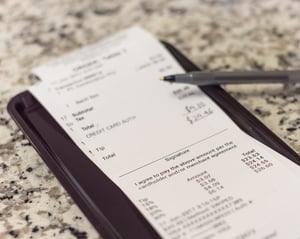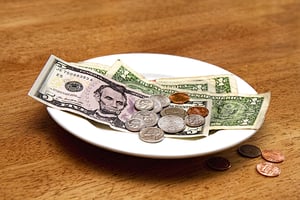Nina and John went out to dinner one night with friends. As usual, at the end of the meal, there was some playful haggling over who who would pick up the check. John volunteered, so Nina offered to cover the tip. This ended up setting off a lively debate about the topic of tipping. In the end, the server walked away with a 20% tip and everyone went home happy.
The Odd History of Tipping
Let’s face it, for most of us, tipping can be a confusing subject. So much so, that if you ask five different people about how much to tip, you might get ten different answers. That’s not surprising as tipping often varies by region and even by industry.
And it is not just confusing for diners. Even independent pizzerias and restaurant owners may find the rules around tipping and employee compensation a little murky. In part, that may stem from the haphazard way tipping itself evolved. Although no one is certain where the custom arose, it seems to have started as early as the Middle Ages. When wealthy visitors stayed at English mansions and castles, they were expected to show some form of appreciation for the servants who cared for them. From there, the custom of tipping seems to have spread to the inns and taverns across Europe until it eventually made its way to America.
Tips and Employee Compensation in America
Tipping did not become popular in the United States until the late 1800’s. And, despite its widespread acceptance, tipping has never been without some degree of controversy. In the early 1900’s for instance, many states moved, unsuccessfully, to ban the practice altogether because they saw it as being condescending to servers, as well as adding a burden to customers. Even now, many restaurants are moving away from the practice for a variety of reasons, not the least of which is to provide a livable wage that employees can depend on without the vagaries of relying on tips.
Still, tipping is deeply rooted in American norms and law, so it is unlikely to go away anytime soon. Additionally, many restaurants see tipping as a way of guaranteeing better service to patrons. Research though, has shown that there is often little correlation between how well servers perform and how much they are tipped.
Changes in Tipping and Wage Rules for Employers
Controversies aside, when it comes to gratuities and employee compensation, correctly calculating wages for tipped employees can be a massive headache, especially with recent changes in regulations.
Nation’s Restaurant News, for example, recently reported that the United States Labor Department (DOL) has abandoned an Obama-era rule known as 80/20 rule. The rule prohibited employers from using the sub-minimum wage structure for non-tipped dual work performed by tipped employees (Examples of non-tipped dual work would include side-work such as prepping for salad bars, sweeping and cleaning, and or rolling silverware.)
The 80/20 Tipped Rule
 Under the previous guidelines, employees who spent more than 20% of their time performing non-tipped duties had to be paid at the higher hourly minimum rate (currently at $7.25 an hour) instead of the reduced wage for servers (currently at $2.13 an hour for employees who receive at least $30 in tips per month).
Under the previous guidelines, employees who spent more than 20% of their time performing non-tipped duties had to be paid at the higher hourly minimum rate (currently at $7.25 an hour) instead of the reduced wage for servers (currently at $2.13 an hour for employees who receive at least $30 in tips per month).
The new guidance allows employers to use the tip credit, even if servers go over the 20%. The DOL stated that there is no limitation for employees who are carrying out non-tipped related work duties, provided that the non-tipped duties are contemporaneously performed within a reasonable amount of time (immediately before or after) tipped duties, and all other requirements of the Act are met.
Side Work Versus Tipped Duties
As a rule, if an employee spends the bulk of their time cleaning or performing side-work, they must be compensated at the higher rate. For instance, if a pizzeria server also holds a dual role as a dishwasher, the tip credit can only be used when the server is able to receive tips, such as when they are serving patrons. If they spend most of their time in the kitchen, they must be compensated for their time in the kitchen at the federal minimum wage rate. This applies to delivery drivers as well.
It should be noted that the new 80/20 guidance is likely to be tested in the courts, and employers are encouraged to stay up to date on all federal DOL requirements. You can learn more about DOL tipping regulations and compliance here.
Payroll for Tipped Drivers
While the rules may seem confusing, there is some good news: our sophisticated POS system automatically and effortlessly calculates driver and server wages, including handling the complexities associated with employee overtime and mileage. For more information about how advanced point-of-sale systems like Thrive help independent pizza restaurants do more, click here.

